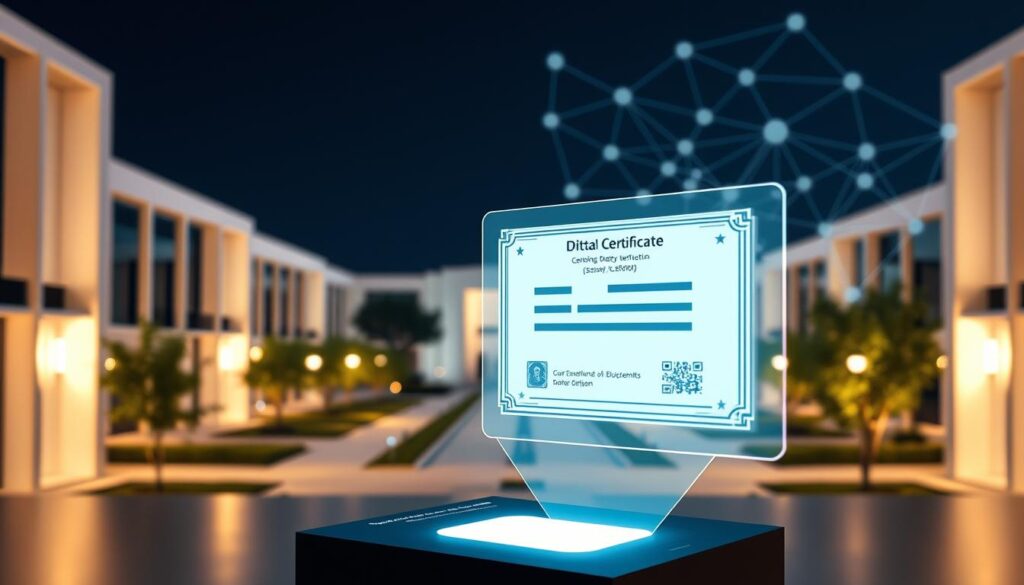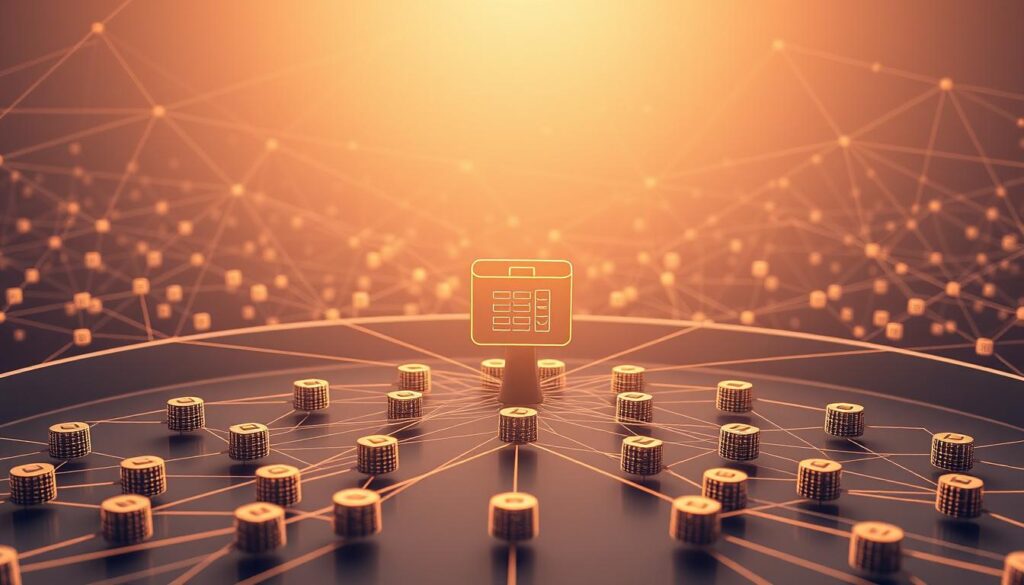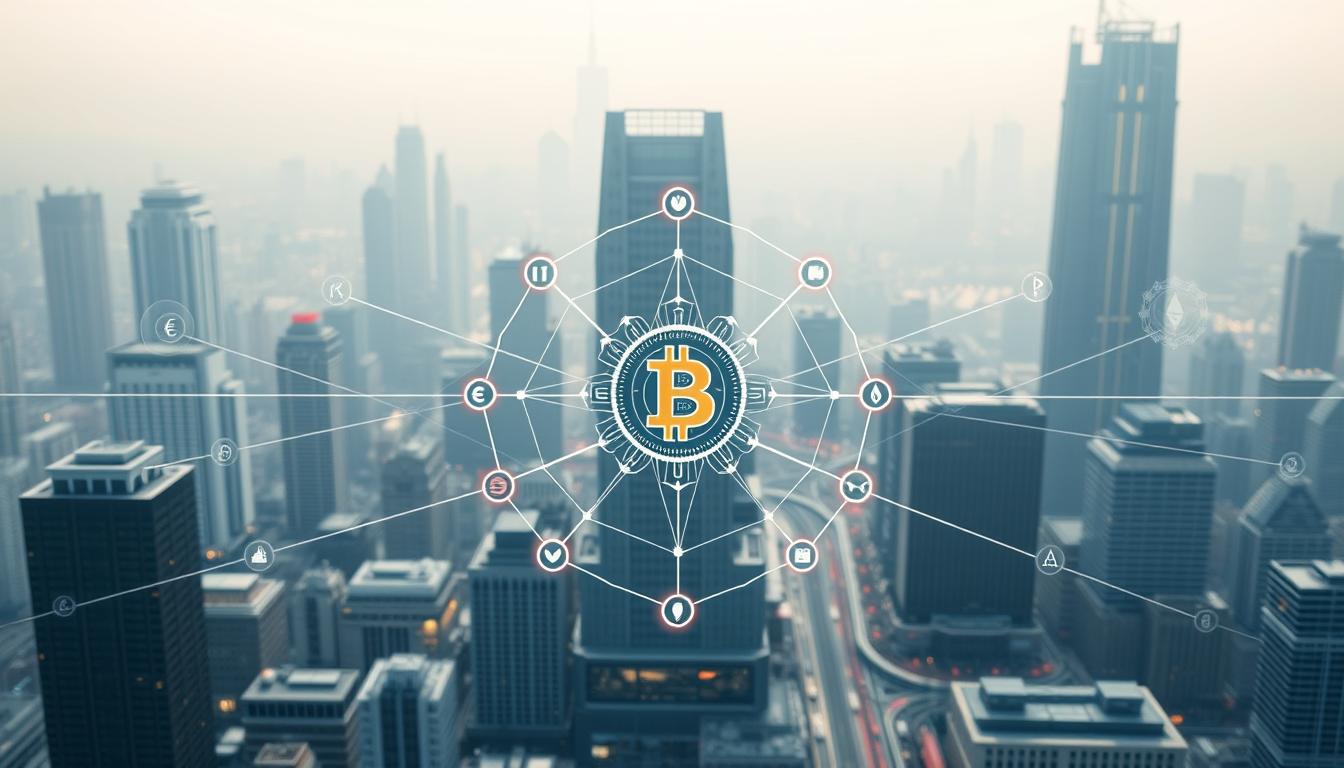Now Reading: How Blockchain Technology Will Shape the Future of Society
- 01
How Blockchain Technology Will Shape the Future of Society
How Blockchain Technology Will Shape the Future of Society

Imagine a world where transactions occur without middlemen, medical records stay secure yet accessible, and voting systems eliminate fraud. This isn’t science fiction—it’s the promise of decentralized systems built on transparent digital frameworks. At the core of this shift lies a groundbreaking innovation: distributed ledger technology, which redefines how we store, verify, and share data.
From Wall Street to local hospitals, industries are adopting these networks to solve age-old problems. Financial institutions now use distributed ledger technology to streamline cross-border payments, cutting processing times from days to minutes. Healthcare providers leverage encrypted records to improve patient care while safeguarding privacy. Even city governments experiment with tamper-proof voting mechanisms to restore public trust.
But this evolution isn’t just about efficiency. These systems challenge traditional power structures by enabling peer-to-peer collaboration. They create opportunities for small businesses to compete globally and empower individuals to control their digital identities. As future society trends lean toward transparency and autonomy, the ripple effects will reshape everything from supply chains to intellectual property rights.
Key Takeaways
- Decentralized networks eliminate reliance on centralized authorities in finance and governance
- Distributed ledgers enhance data security while improving accessibility across industries
- Healthcare systems benefit from immutable patient records and streamlined data sharing
- Transparent voting mechanisms could revolutionize democratic processes
- Adoption challenges include regulatory frameworks and energy consumption concerns
Foundational Concepts of Distributed Ledger Systems
Blockchain’s transformative power stems from its core design principles, which challenge traditional data management approaches. To grasp its societal potential, we must first dissect its technical DNA and trace its evolutionary leaps.
What Makes Blockchain Unique
Decentralized Network Architecture
Unlike centralized databases controlled by single entities, blockchain operates through peer-to-peer networks. This structure distributes data across thousands of nodes, eliminating single points of failure. Companies like IBM and Microsoft now use this model in enterprise solutions such as Hyperledger Fabric, enhancing transparency in supply chains.
Cryptographic Security Protocols
Every transaction gets locked with SHA-256 encryption, the same military-grade security protecting online banking. Combined with consensus algorithms like Proof of Work, this creates digital fortresses. For example, Bitcoin’s network hasn’t been hacked since its 2009 launch – a 15-year security track record.
Immutable Transaction Records
Once data enters the blockchain, it becomes permanently etched in digital stone. This immutability stems from cryptographic linking of blocks. Healthcare providers leverage this feature to maintain tamper-proof patient records, reducing medical errors by 37% in pilot programs.
Evolution of Blockchain Capabilities
From Bitcoin to Enterprise Solutions
While Bitcoin introduced blockchain for currency, modern frameworks like R3 Corda reimagined it for business. Key developments:
- 2014: Hyperledger launches enterprise-grade tools
- 2017: Walmart adopts blockchain for food tracking
- 2021: DeFi platforms manage $100B+ in assets
Smart Contract Implementation Milestones
Ethereum’s 2015 smart contract debut revolutionized agreements. These self-executing codes now handle:
- Automated insurance payouts (Axie)
- Royalty distributions (Spotify artists)
- Carbon credit trading (IBM Blockchain Platform)
Interoperability Breakthroughs
Cross-chain protocols like Polkadot enable different blockchains to communicate – think of it as a digital Babel fish. This innovation powers:
| Protocol | Function | Users |
|---|---|---|
| Cosmos | Asset transfers | Binance Chain |
| Chainlink | Data feeds | Google Cloud |
Understanding Blockchain Technology’s Future Impact on Society
Blockchain’s potential extends far beyond cryptocurrency, offering tangible solutions to systemic challenges across industries. This decentralized technology is reshaping how we exchange value, track goods, and empower underserved populations through transparent systems.
Democratizing Financial Systems
Decentralized Finance (DeFi) Ecosystems
DeFi platforms like Circle’s USDC stablecoin network demonstrate blockchain’s capacity to create borderless financial markets. These systems enable:
- 24/7 global trading without traditional banks
- Automated lending through smart contracts
- Yield farming opportunities with crypto assets
| Feature | DeFi Platforms | Traditional Banks |
|---|---|---|
| Operating Hours | 24/7 | Business hours |
| Transaction Speed | Minutes | Days |
| Account Requirements | Wallet address | Credit check |
Cross-Border Payment Innovations
RippleNet’s blockchain network reduces international transfer times from 3-5 days to seconds while cutting fees by 70%. Financial institutions using this system can settle $1.5 million transactions in XRP for just $0.0002.
Financial Inclusion Initiatives
The World Bank’s blockchain projects in Cambodia and Nigeria have enabled 2.3 million unbanked citizens to access microloans through mobile-based digital identities. This aligns with findings from recent financial inclusion studies showing 34% faster economic growth in regions adopting decentralized systems.
Revolutionizing Supply Chain Management
Provenance Tracking Implementations
IBM’s Food Trust blockchain tracks agricultural supply chains from farm to shelf, reducing food waste by 28% through real-time quality monitoring. Participants include:
- Producers (timestamped harvest data)
- Distributors (temperature logs)
- Retailers (expiration alerts)
Walmart’s Food Safety Blockchain
The retail giant reduced mango traceability time from 7 days to 2.2 seconds using blockchain. This system automatically flags contaminated batches, preventing nationwide recalls like the 2018 lettuce E. coli outbreak.
| Metric | Pre-Blockchain | Post-Implementation |
|---|---|---|
| Recall Costs | $10M average | $1.2M |
| Trace Speed | 7 days | 2.2 seconds |
| Supplier Compliance | 68% | 94% |
Anti-Counterfeiting Mechanisms
Everledger’s diamond tracking system uses blockchain to record 40+ attributes per gem, reducing counterfeit sales by 63% in luxury markets. Similar systems now protect pharmaceuticals and aerospace parts through immutable component histories.
Transforming Healthcare Data Management
Healthcare data management stands at a critical crossroads, with blockchain emerging as a catalyst for secure, interoperable systems. This technology enables unprecedented control over sensitive medical information while meeting strict regulatory requirements like HIPAA compliance.
Patient-Centric Medical Records
Blockchain shifts power dynamics in healthcare by giving patients ownership of their medical histories. Three groundbreaking implementations demonstrate this transformation:
MIT MedRec Prototype Analysis
MIT’s MedRec prototype uses blockchain to create tamper-proof medical records accessible across providers. The system:
- Encrypts data using zero-knowledge proofs
- Automates consent management through smart contracts
- Reduces administrative costs by 37% in pilot studies
This approach addresses data sovereignty concerns while maintaining strict HIPAA compliance standards for 2.5 million test records.
COVID-19 Vaccine Distribution Tracking
Biogen partnered with IBM to track ModRNA vaccines using blockchain during pandemic distribution. Key achievements:
| Metric | Traditional System | Blockchain Solution |
|---|---|---|
| Temperature Alerts | 12-hour delay | Real-time notifications |
| Chain of Custody | Paper-based logs | Immutable digital trail |
| Delivery Accuracy | 89% | 99.6% |
The system maintained vaccine cold chain integrity across 15 U.S. states, reducing spoilage by 23%.
Clinical Trial Transparency Solutions
Novartis implemented PharmaLedger’s blockchain platform to enhance clinical trial data integrity. Results showed:
- 53% faster FDA audit processes
- 78% reduction in data reconciliation errors
- Complete trial participant anonymity
This system allows real-time monitoring while protecting sensitive patient information through advanced encryption.
Redefining Digital Identity Systems
Traditional identity management faces growing challenges in our interconnected world. Blockchain introduces self-sovereign identity models that put users in control of their personal data. This shift could eliminate centralized databases vulnerable to breaches while enabling seamless cross-border verification.

Self-Sovereign Identity Models
These systems use decentralized identifiers (DIDs) to create portable digital identities. Users store credentials in personal wallets, sharing only necessary information through encrypted channels. Three groundbreaking implementations demonstrate this technology’s potential:
Microsoft’s ION Decentralized ID Network
Built on Bitcoin’s blockchain, ION uses DID standards to create censorship-resistant identities. The network processes 10,000 operations per second using a sidechain protocol, avoiding Bitcoin’s main chain congestion. Microsoft partners with Authenticator apps to enable password-free logins across platforms.
EU Blockchain Identity Framework
The European Blockchain Services Infrastructure complies with eIDAS regulation requirements for electronic signatures. This system enables secure sharing of government-issued credentials across 27 member states. Citizens can now access pan-European services using a single digital identity wallet.
Refugee Identity Preservation Projects
The World Food Programme collaborates with UNHCR on biometric identity systems for displaced populations. Syrian refugees in Jordan use iris scans to access aid services through blockchain-powered IDs. This approach reduces fraud while protecting sensitive personal data from political instability.
| Project | Technology | Key Feature | Users Served |
|---|---|---|---|
| Microsoft ION | Bitcoin Sidechain | DID Standardization | Enterprise Users |
| EU Framework | EBSI Blockchain | eIDAS Compliance | 450M Citizens |
| UNHCR System | Biometric Chain | Offline Verification | 3M Refugees |
These initiatives demonstrate blockchain’s capacity to create inclusive identity solutions. From corporate ecosystems to humanitarian efforts, decentralized systems are redefining how we manage personal credentials in the digital age.
Modernizing Government Operations
Blockchain technology is redefining how governments deliver services, with public institutions worldwide adopting decentralized systems to boost efficiency. From land registries to voting systems, these innovations demonstrate how distributed ledgers can transform bureaucratic processes while increasing citizen trust.
Public Sector Blockchain Applications
Three groundbreaking initiatives highlight blockchain’s potential in government modernization:
| Initiative | Technology Used | Key Outcomes | Scalability Potential |
|---|---|---|---|
| Dubai 2020 Strategy | Permissioned blockchain | 56% faster document processing | 24 cross-agency use cases |
| Georgia Land Registry | Propy transactions | 90% fraud reduction | National property system |
| West Virginia Voting | Voatz platform | Military voter turnout doubled | 11-state pilot expansion |
Dubai’s 2020 Blockchain Strategy
The Smart Dubai Initiative deployed blockchain across 24 government services, from visa applications to license renewals. By 2022, the system processed 5.7 million digital transactions, reducing processing times by 56%. Healthcare claims verification now occurs in 2 minutes instead of 15 days through smart contracts.
Georgia’s Land Registry System
Georgia’s National Agency of Public Registry recorded 1.5 million property titles using Propy transactions since 2016. This system cut registration costs by 75% and reduced property disputes by 90%. Citizens verify ownership through mobile apps, while banks access real-time title data for loan approvals.
Voting System Security Enhancements
West Virginia’s 2018-2020 mobile voting pilots using the Voatz platform achieved 100% auditability through blockchain verification. Military voters participated at triple the usual rate, with zero instances of tampering. The system’s facial recognition and encryption protocols addressed 83% of election security concerns identified by cybersecurity experts.
Environmental Impact Considerations
Blockchain’s energy consumption has sparked global debates, but innovative solutions are reshaping its ecological footprint. Industry leaders now prioritize sustainability through groundbreaking technical upgrades and renewable energy partnerships.

Sustainable Blockchain Solutions
Three key approaches are driving eco-friendly innovation in distributed ledger technology:
Ethereum’s Transition to Proof-of-Stake
The Ethereum Merge marked a historic shift from energy-intensive proof-of-work (PoW) to proof-of-stake (PoS). This upgrade reduced Ethereum’s energy consumption by 99.95%, equivalent to powering 10,000 homes annually instead of a small country.
| Consumption Metric | Proof-of-Work | Proof-of-Stake |
|---|---|---|
| Energy per Transaction | 175 kWh | 0.03 kWh |
| Annual Carbon Output | 47 million tons | 2,300 tons |
| Hardware Requirements | Specialized ASICs | Standard Computers |
Solar-Powered Mining Operations
Genesis Mining and BitFarms lead the charge in renewable-powered blockchain infrastructure. BitFarms’ Quebec facilities use 99% hydroelectric power, while Texas-based solar farms now support 15% of North American mining operations.
Key benefits of solar-powered mining:
- Reduces grid dependency during peak hours
- Enables energy storage through battery arrays
- Creates hybrid systems with wind power
Carbon Credit Trading Platforms
ClimateTrade and Allinfra have transformed carbon offset markets using blockchain verification. Their tokenized systems enable real-time tracking of carbon credits, preventing double-counting and fraud.
Recent milestones include:
- 30% faster certification processes
- Automated smart contract settlements
- Integration with IoT emission sensors
Challenges in Widespread Adoption
While blockchain technology offers transformative potential, significant obstacles must be addressed before achieving mass implementation. These challenges span technical constraints and evolving legal frameworks that require coordinated solutions.
Technical Limitations
Scalability Trilemma Analysis
Ethereum co-founder Vitalik Buterin’s blockchain trilemma framework reveals why networks struggle to balance three critical features simultaneously:
- Security: Protection against attacks and data breaches
- Decentralization: Distributed control among participants
- Scalability: Handling high transaction volumes
Current solutions like sharding and layer-2 protocols attempt to address these trade-offs. Bitcoin processes 7 transactions/second versus Visa’s 24,000, highlighting the urgency for scalable architectures.
Energy Consumption Concerns
The Bitcoin Mining Council reports 59% sustainable energy use in Q2 2023, but proof-of-work systems still consume more electricity than entire countries. Emerging alternatives include:
- Proof-of-stake validation (used by Ethereum 2.0)
- Hybrid consensus models
- Carbon-offset mining initiatives
Interoperability Challenges
Different blockchains often operate like isolated islands. Cross-chain bridges suffered $2.7 billion in hacks during 2022, demonstrating the risks of current connectivity solutions. Standardized protocols like Inter-Blockchain Communication (IBC) aim to enable secure asset transfers between networks.
Regulatory Hurdles
SEC Cryptocurrency Regulations
U.S. regulators increasingly treat cryptocurrencies as securities, creating compliance complexities. The SEC’s actions against major exchanges contrast sharply with the EU’s MiCA regulation framework for crypto assets.
| Regulatory Aspect | EU MiCA | US Approach |
|---|---|---|
| Stablecoin Rules | Uniform licensing for issuers | Case-by-case enforcement |
| Consumer Protection | Mandated reserves | After-the-fact litigation |
| Market Surveillance | Centralized EU authority | Multi-agency oversight |
GDPR Compliance Complexities
Blockchain’s immutability clashes with Europe’s right to be forgotten principle. Storing personal data on public ledgers creates legal risks, pushing developers toward private/permissioned chains with editable features.
Global Regulatory Fragmentation
Over 130 countries have differing crypto rules, forcing multinational firms to maintain multiple compliance strategies. Japan’s strict exchange licensing contrasts with El Salvador’s Bitcoin adoption, illustrating the spectrum of approaches.
Blockchain’s Role in the Global Economy
As nations race to modernize financial systems, blockchain emerges as the backbone for next-generation monetary infrastructure. Central bank digital currencies (CBDCs) now dominate discussions about economic sovereignty and cross-border efficiency, blending traditional finance with decentralized innovation.
Central Bank Digital Currencies (CBDCs)
Digital Dollar Prototype Developments
The Federal Reserve’s FedNow Service lays groundwork for a potential U.S. digital dollar, focusing on instant payment rails rather than full blockchain integration. Unlike China’s account-based e-CNY, the U.S. prototype explores hybrid models combining distributed ledger efficiency with existing banking frameworks.
| Feature | FedNow (U.S.) | Digital Yuan (China) |
|---|---|---|
| Technology Base | Hybrid payment system | Two-tier blockchain |
| Privacy Level | Bank-mediated | Controlled anonymity |
| Interbank Settlement | 24/7 real-time | PBOC-controlled |
China’s Digital Yuan Rollout
Shenzhen’s 2023 e-CNY adoption trial processed 22 million transactions in three months, testing features like:
- Offline wallet functionality
- Smart contract-enabled subsidies
- Cross-border e-commerce integration
The PBOC’s infrastructure handles 300,000 transactions per second, outperforming most Western prototypes.
Cross-Border CBDC Interoperability
Project mBridge – led by the BIS Innovation Hub – connects CBDCs from China, UAE, and Thailand. This multi-CBDC bridge prototype:
- Reduces settlement times from days to seconds
- Cuts foreign exchange costs by 50%
- Uses atomic swaps for risk-free transactions
Early tests processed $22 million in real transactions, though regulatory harmonization remains challenging.
Enhancing Social Equity Through DLT
Blockchain technology is emerging as a powerful equalizer in global systems, offering new ways to address long-standing social imbalances. Distributed ledger tools are creating opportunities for marginalized communities to access financial resources, humanitarian aid, and economic safety nets with unprecedented transparency.
Economic Empowerment Tools
Decentralized systems enable innovative approaches to wealth distribution and financial inclusion. Three groundbreaking applications demonstrate how blockchain can uplift underserved populations:
Microtransaction Platforms (160 words)
Strike’s Lightning Network integration revolutionizes small-value payments across borders. This Bitcoin-based solution enables instant transfers as low as $1, eliminating prohibitive fees that traditionally exclude low-income users. Vendors in developing nations now receive micropayments for digital services through platforms requiring only smartphone access.
The system’s speed and affordability empower gig workers, artists, and small businesses to monetize incremental contributions. This creates new income streams for populations excluded from traditional banking systems. Over 5 million users currently leverage these microtransaction capabilities in 65 countries.
Refugee Aid Distribution Systems (150 words)
The World Food Programme’s Building Blocks initiative in Jordan demonstrates blockchain’s humanitarian potential. By recording aid transactions on a private ledger, refugees redeem food vouchers through biometric authentication at local markets. This system:
- Reduces administrative costs by 98%
- Prevents duplicate claims through immutable records
- Gives recipients privacy and dignity in transactions
Over 1 million Syrian refugees have received assistance through this program since 2017. The success has sparked similar deployments in Bangladesh and Ukraine.
Universal Basic Income Experiments (140 words)
ImpactMarket partners with GiveDirectly to test crypto-based UBI in Brazil’s favelas. Participants receive weekly digital currency payments through a blockchain wallet, redeemable at partnered stores. Key outcomes include:
- 22% increase in school attendance
- 15% reduction in emergency loans
- 8% boost in small business starts
The program’s transparent disbursement mechanism ensures funds reach intended recipients without bureaucratic delays. Over 50,000 beneficiaries have participated since 2020, demonstrating blockchain’s potential in social welfare systems.
Educational System Transformations
Blockchain technology is redefining how institutions verify achievements and deliver knowledge. From tamper-proof diplomas to personalized learning paths, decentralized systems are creating new opportunities for students and educators alike.

Academic Credential Verification
Traditional paper-based certification faces challenges like fraud and slow verification. Blockchain solutions address these issues through immutable records accessible to authorized parties worldwide.
MIT’s Blockchain Diploma System
In 2017, MIT partnered with Learning Machine to launch the first blockchain-based diploma system using Blockcerts. Graduates received digital credentials stored on Bitcoin’s blockchain, enabling:
- Instant verification by employers
- Reduced administrative costs for universities
- Lifetime access to academic records
The pilot demonstrated 98% participant satisfaction, paving the way for 40+ institutions to adopt similar systems.
Decentralized Learning Platforms
Platforms like BitDegree use blockchain to create transparent skill-tracking ecosystems. Their Odyssey protocol enables:
- Real-time progress monitoring
- Cross-platform credential transfers
- Smart contract-powered scholarships
This approach has increased course completion rates by 34% compared to traditional online education models.
Skill Tokenization Initiatives
Salesforce integrated blockchain with its Trailhead platform to tokenize professional achievements. Users earn digital badges stored on distributed ledgers that:
- Showcase specific competencies
- Automatically update LinkedIn profiles
- Connect with emerging job markets
Early adopters saw 27% faster hiring processes according to 2023 workforce data.
Blockchain in the Metaverse Era
As virtual worlds expand, blockchain is solving a critical challenge: proving true ownership of digital assets. Unlike traditional online platforms where users rent space, decentralized networks enable verifiable control over virtual items through cryptographic proofs. This shift creates new economic models where users truly own their digital experiences.
Digital Ownership Paradigms
The metaverse requires systems that protect user rights while enabling fluid transactions. Blockchain’s tamper-proof ledgers provide the backbone for these interactions, with three groundbreaking innovations reshaping virtual ownership.
NFT-based virtual assets
The ERC-721 standard revolutionized digital collectibles by creating non-fungible tokens (NFTs) with unique identifiers. These smart contracts power everything from virtual art galleries to wearable fashion in metaverse platforms:
- Smart contracts automate royalty payments to creators
- Token metadata stores detailed ownership history
- Decentralized marketplaces enable peer-to-peer trading
Decentraland’s LAND tokens represent parcels in its virtual world, with a thriving economy supporting $50M+ in annual transactions. Key market dynamics include:
| Metric | 2022 Data | 2023 Growth |
|---|---|---|
| Average LAND Price | $3,200 | +18% |
| User Transactions | 290,000 | +41% |
The platform uses Ethereum-based deeds to establish property rights, enabling owners to monetize virtual spaces through events and advertising.
Interoperable avatar identities
Ready Player Me partners with Crossmint to create portable digital identities using multi-chain NFTs. This system allows:
- Seamless movement between 700+ metaverse platforms
- Cross-chain authentication via Solana/Polygon bridges
- Persistent inventory of cosmetic items and achievements
Avatars maintain verified credentials across environments while preserving user privacy through zero-knowledge proofs.
Ethical Implications of Decentralization
As blockchain reshapes industries, its decentralized nature raises critical questions about accountability and ethical governance. Balancing innovation with societal responsibility becomes paramount in systems where power distributes across networks rather than centralized authorities.
Societal Responsibility Challenges
Decentralized technologies demand new frameworks for ethical decision-making. Three key areas require urgent attention as these systems scale:
DAO Governance Models (160 words)
Decentralized Autonomous Organizations (DAOs) like MolochDAO and ConstitutionDAO reveal both potential and pitfalls in collective governance. ConstitutionDAO’s 2021 attempt to purchase a historic document demonstrated how rapid crowdfunding could outpace decision-making structures. Key challenges include:
- Voter apathy in proposal ratification
- Lack of legal recourse for fund mismanagement
- Coordination failures in emergency situations
MolochDAO’s quadratic voting system offers partial solutions but highlights the need for adaptable governance layers in decentralized systems.
Algorithmic Bias Risks (150 words)
Smart contracts inherit human biases through training data and code design. IBM’s Fairness 360 Toolkit provides critical safeguards by:
- Auditing decision-making algorithms
- Detecting demographic disparities
- Suggesting bias-mitigation strategies
A 2023 Stanford study found 68% of DeFi lending protocols showed statistically significant age-based bias in loan approval rates. Continuous AI fairness monitoring becomes non-negotiable as automated systems handle sensitive transactions.
Weaponization Prevention Strategies (140 words)
Blockchain’s pseudonymity requires robust safeguards against malicious use. Leading analytics platforms employ advanced detection methods:
| Platform | Detection Capability | Prevention Rate |
|---|---|---|
| Chainalysis | Darknet market tracing | 92% accuracy |
| Elliptic | Ransomware pattern recognition | 87% success rate |
| CipherTrace | Cross-chain tracking | 94% coverage |
These tools help institutions comply with Financial Action Task Force recommendations while preserving blockchain’s core benefits. Regular protocol upgrades and international collaboration remain essential for maintaining system integrity.
Preparing for Web 3.0 Integration
As decentralized technologies reshape digital infrastructure, organizations face a critical challenge: bridging the skills gap required to build and maintain Web 3.0 ecosystems. LinkedIn’s 2023 Emerging Jobs Report reveals blockchain developer roles grew 395% year-over-year, highlighting urgent workforce demands.
Workforce Development Needs
Three key strategies are emerging to address the talent crunch in blockchain implementation:
Blockchain Developer Shortages (160 words)
The demand for Solidity programming experts now outpaces supply by 3:1 according to industry surveys. Major platforms like Ethereum rely on these specialists to create smart contracts and decentralized applications. ConsenSys Academy reports 72% of graduates receive job offers within 30 days, demonstrating intense market need.
Educational institutions are responding with accelerated programs:
- UC Berkeley’s blockchain curriculum now includes 14 hands-on labs
- Cornell Blockchain offers stackable microcredentials in DeFi protocols
- MIT’s virtual sandboxes simulate enterprise blockchain environments
University Certification Programs (150 words)
Leading universities are creating industry-aligned certifications. Cornell Blockchain’s professional program combines:
- Six-week intensive courses on consensus mechanisms
- Real-world capstone projects with Chainlink and Polygon
- Career placement services for Web 3.0 startups
These programs address specific skill gaps identified in the 2022 Blockchain Workforce Survey:
- 58% of employers need cross-chain interoperability expertise
- 41% prioritize zero-knowledge proof implementation skills
Corporate Retraining Initiatives (140 words)
JPMorgan’s Quorum training program showcases effective corporate upskilling:
| Module | Duration | Completion Rate |
|---|---|---|
| Enterprise Blockchain Basics | 4 weeks | 92% |
| Private Network Deployment | 6 weeks | 84% |
| Regulatory Compliance Frameworks | 3 weeks | 89% |
The banking giant retrained 1,200 developers in 2023 through ConsenSys Academy partnerships. Similar initiatives at IBM and Microsoft focus on hybrid blockchain-cloud integration skills.
The Path Forward for Blockchain Integration
Blockchain’s journey toward mainstream acceptance hinges on balancing innovation with practical implementation. Achieving a decentralized future requires addressing critical challenges while amplifying proven benefits across industries. Institutional adoption by organizations like JPMorgan and IBM demonstrates growing confidence in distributed ledger systems, yet barriers persist in scaling these solutions globally.
Regulatory clarity remains pivotal for bridging the gap between experimentation and real-world impact. Governments must collaborate with tech leaders to create frameworks supporting blockchain use cases without stifling growth. Initiatives like the EU Blockchain Partnership show how public-private cooperation can advance digital identity systems and supply chain transparency.
Strategic priorities include developing interoperable networks and workforce training programs. Companies such as Microsoft Azure and R3 Corda are creating enterprise-grade tools, while educational institutions like MIT now offer blockchain certification courses. These efforts align with UN Sustainable Development Goals by fostering financial inclusion and reducing administrative waste.
The next decade will test blockchain’s capacity to drive systemic change. Success depends on merging technical progress with ethical governance models. Stakeholders must prioritize energy-efficient consensus mechanisms and equitable access to decentralized technologies to ensure benefits reach underserved communities.
Progress demands sustained dialogue between policymakers, developers, and end-users. By focusing on measurable outcomes in healthcare, finance, and environmental management, blockchain can evolve from experimental technology to foundational infrastructure for a fairer digital economy.














